Lyon will face Marseille in the quarter-finals of Coupe de France in what is anticipated to be a highly exciting match.
Lyon by far have the better record when meeting Marseille, winning four of their last five clashes. Marseille, however, were the victors in their last meeting. The side that are currently managed by André Villas-Boas earned three points after beating Lyon 2-1 at Stade Vélodrome in matchday 13 of Ligue 1 in November.
Rudi Garcia’s side have been rather inconsistent lately albeit in a pretty decent run. Two wins, two losses, and a draw in their last five matches. Meanwhile, Dimitri Payet and co. are in excellent form this season and have been unbeaten in 16 matches in a row in all competitions. It will be very interesting to see the battle of tactics between the two managers and see which team come out on top.
In this tactical analysis, we’ll give you a preview of both team’s tactics and how they might set up in this game.
Lyon’s style of play
Under Garcia, Lyon tend to be rather patient when in possession. They tend to play from the back and will move the ball around, looking for gaps to exploit so they can progress the ball and attack the opposition.
They mostly utilise short or medium-range passes, only launching long balls if the short options are unavailable or if they’re looking to switch play.
Their structure in the build-up may vary depending on the formation or personnel Garcia picked. The choice of formation usually revolves around using 4-2-3-1/4-4-2 or 4-3-3/4-1-4-1. Occasionally, Lyon can also be seen playing in a 3-4-3 formation.
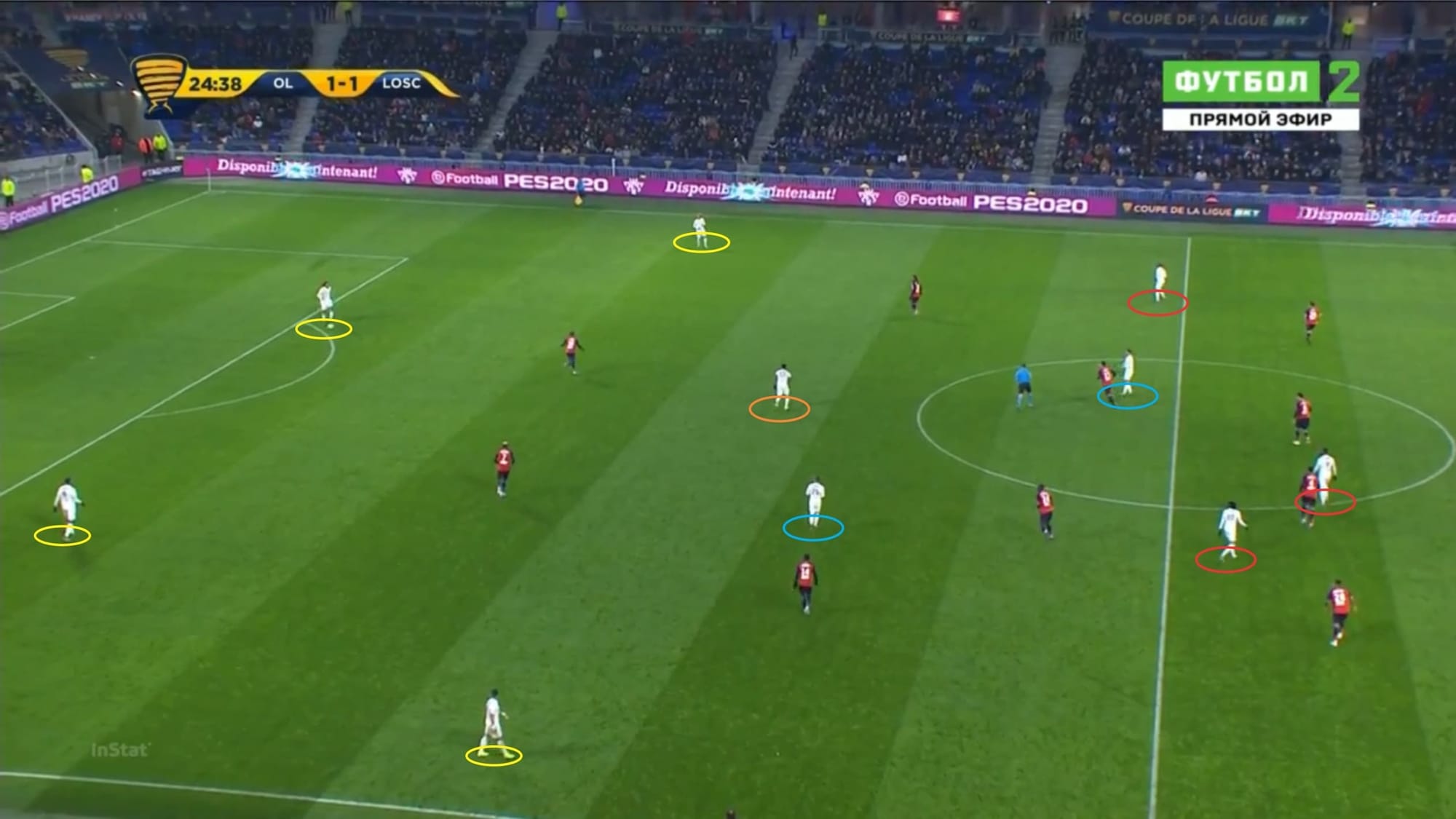
Above is an example of Lyon’s most common structure in the build-up. The goalkeeper would play short to one of the centre-backs and the two centre-backs would then split rather than stay narrow. The two full-backs would sit rather high but would look to drop back if needed.
In this particular situation, Lyon played against Lille in a 4-3-3 formation with Thiago Mendes being the lone pivot in the defensive midfielder position which allowed Houssem Aouar and Maxence Caqueret to sit higher in and around the half-spaces. The same structure can also be created in a 4-2-3-1 formation with one of the two defensive/central midfielders moving into more advanced areas while one stays in the six space. However, if there’s some trouble in progressing the ball in the build-up the defensive/central midfielder who moved up will drop back and offer passing option or drag his marker away to allow the central defender some space to drive with the ball.
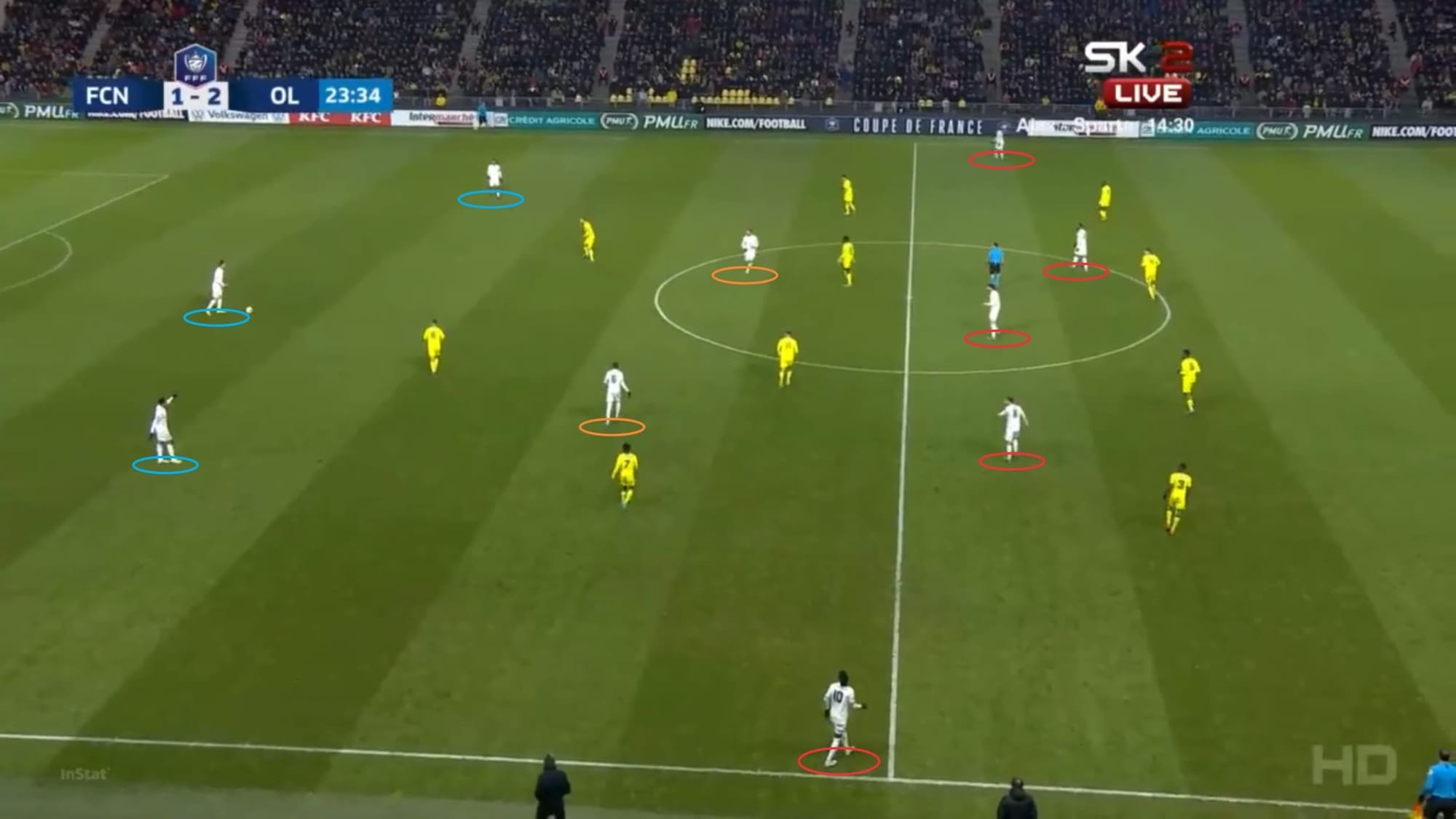
Some other times, in a 3-4-3 formation or when a defensive full-back like Kenny Tete plays in a 4-2-3-1/4-4-2 formation, Lyon will create this 3-2-5 shape in the build-up.
In this particular situation, Lyon played against Nantes in a 4-4-2 formation. As usual, the goalkeeper distributed the ball short. One of the full-backs would move into an advanced position (in this case Maxwel Cornet), meanwhile Tete stayed deep and sit beside the two centre-backs – who stayed narrow this time instead of splitting wide. This shape actually offered better circulation at the back as Lyon seemed to be able to play the ball around laterally due to their superior number against Nantes’ first line (3v2).
Lyon have the tendency to attack through the flanks. However, they have different ways to progress the ball in the build-up.
When they’re facing teams who tended to crowd the middle (such as Lille and Nantes in the examples above), they’d look to avoid playing centrally and access the flanks immediately in the build-up. The centre-back will try to pass the ball towards the nearest full-back and they’ll attack that flank. If that area is overloaded, they’ll go back and reset the play or switch the play towards the other flank.
Against teams who’d block access to wide areas, the centre-back will try to play the ball to the pivot and upon receiving the pass, the latter will usually move the ball wide again by playing it towards either the full-back or the winger.
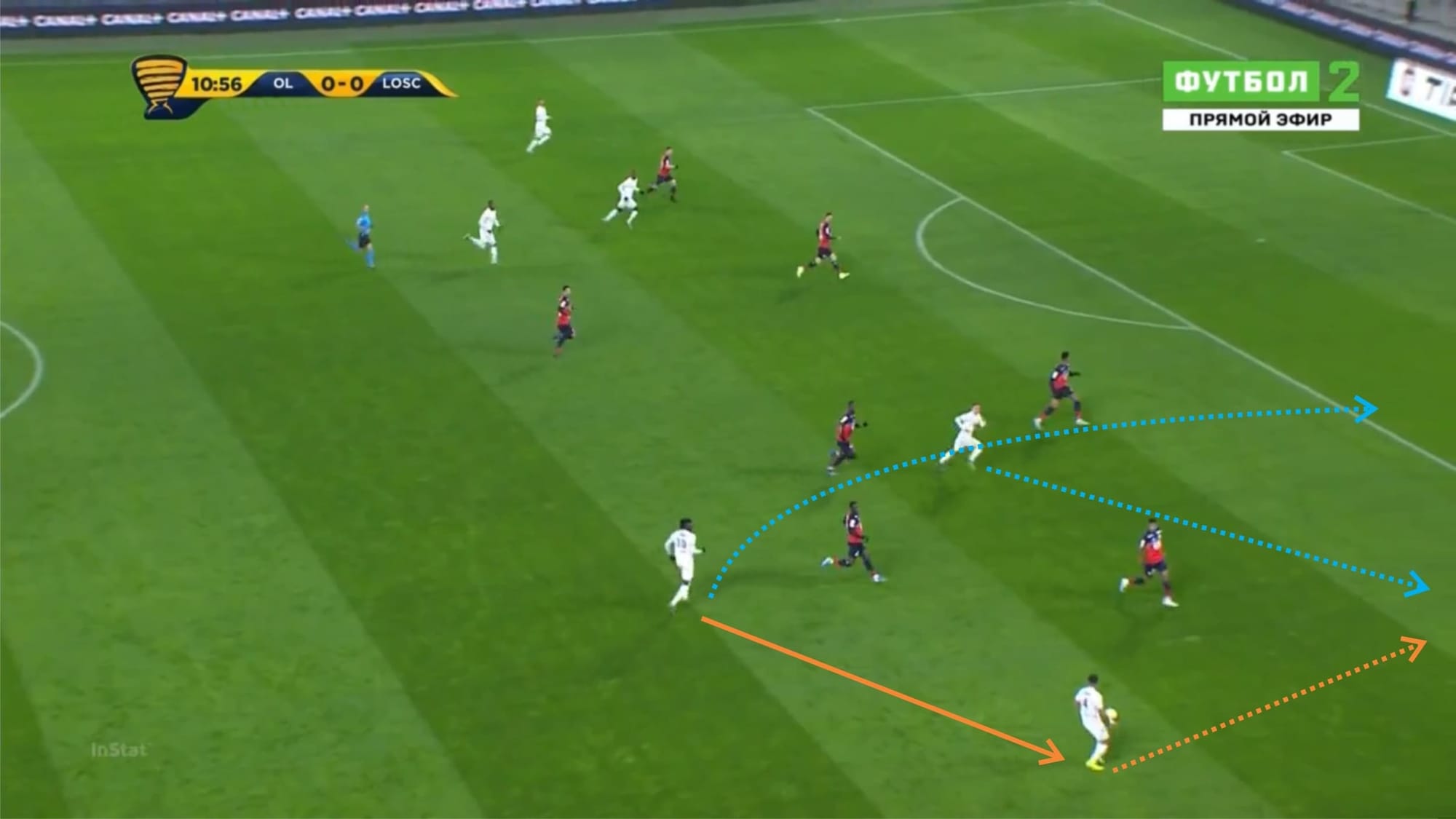
Lyon’s players positioning in wider areas are quite flexible but actually rather simple. This wide rotation allows the creation of space as well as options.
In the example above, Bertrand Traoré passed the ball to Rafael who advanced forward. Caqueret saw an opportunity to exploit the wider areas and moved into that space. Meanwhile, Traoré moved into the space Caqueret previously occupied. Rafael had multiple choices here, either he could pass the ball through to Caqueret or to Traoré or he could drive forward himself while Traoré and Caqueret each occupied one defender. Ultimately, the right-back decided to pass the ball through to Caqueret which is pretty much the safest choice.
Lyon are rather quick on the break and Marseille will need to be careful of the pace they have up front and their ability to get the ball into the opposition half and convert their chances when in the attacking transition.
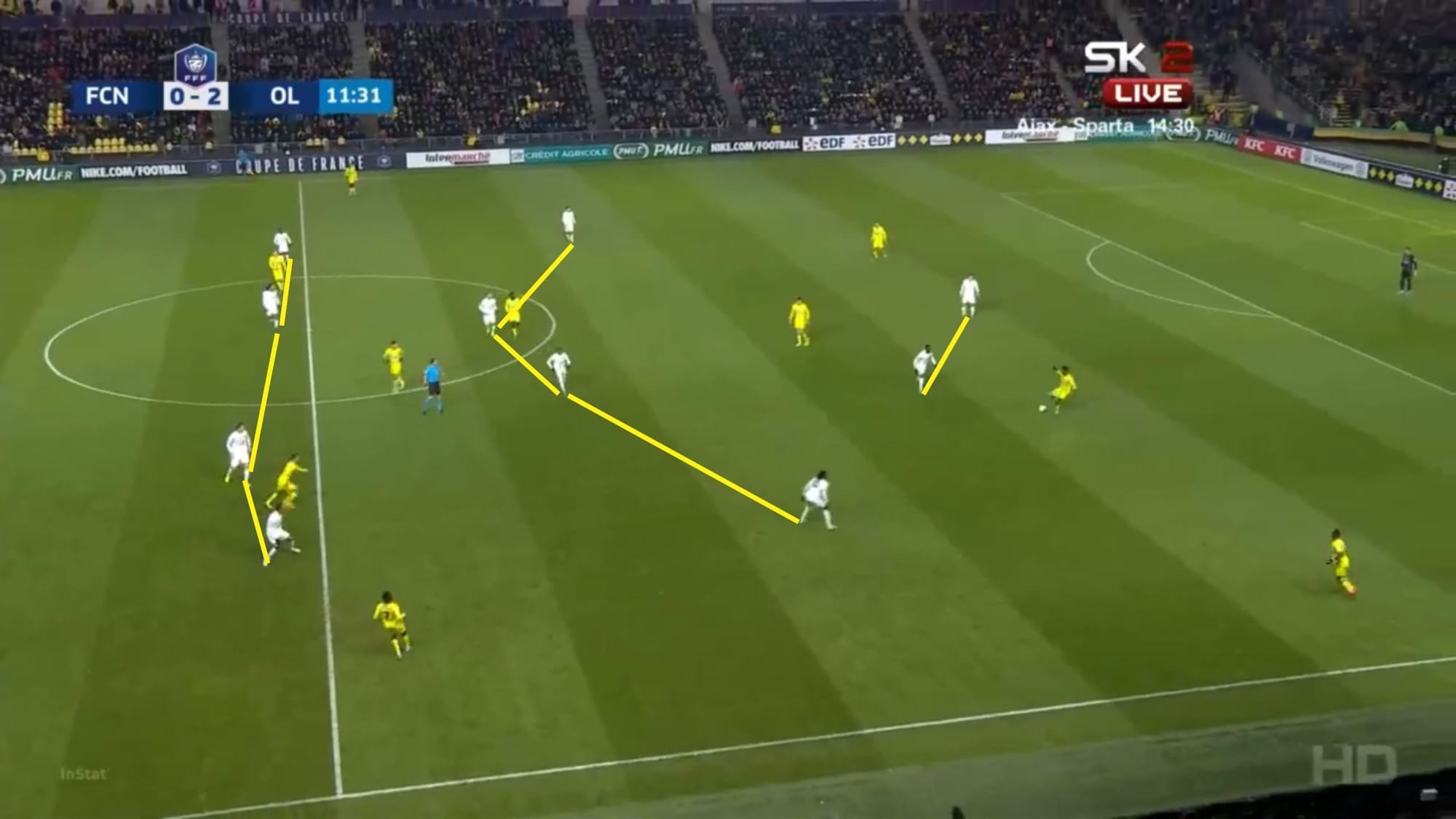
Lyon tend to defend with a high block and pressed high upfront. In a 4-4-2 or 4-2-3-1 formation, they’ll create a compact 4-4-2 block as in the example above. Meanwhile, in a 4-3-3 or 4-1-4-1 formation, they’ll defend in a 4-1-4-1 block with only one man in the first line and one man protecting the area in front of the defence.
Lyon always seek to defend as a unit and will try to keep the shape compact and narrow. They mainly defend zonally, with the position of the ball being the reference point. This means that the players will look to move and defend the area depending on where the ball is and the options around the ball.
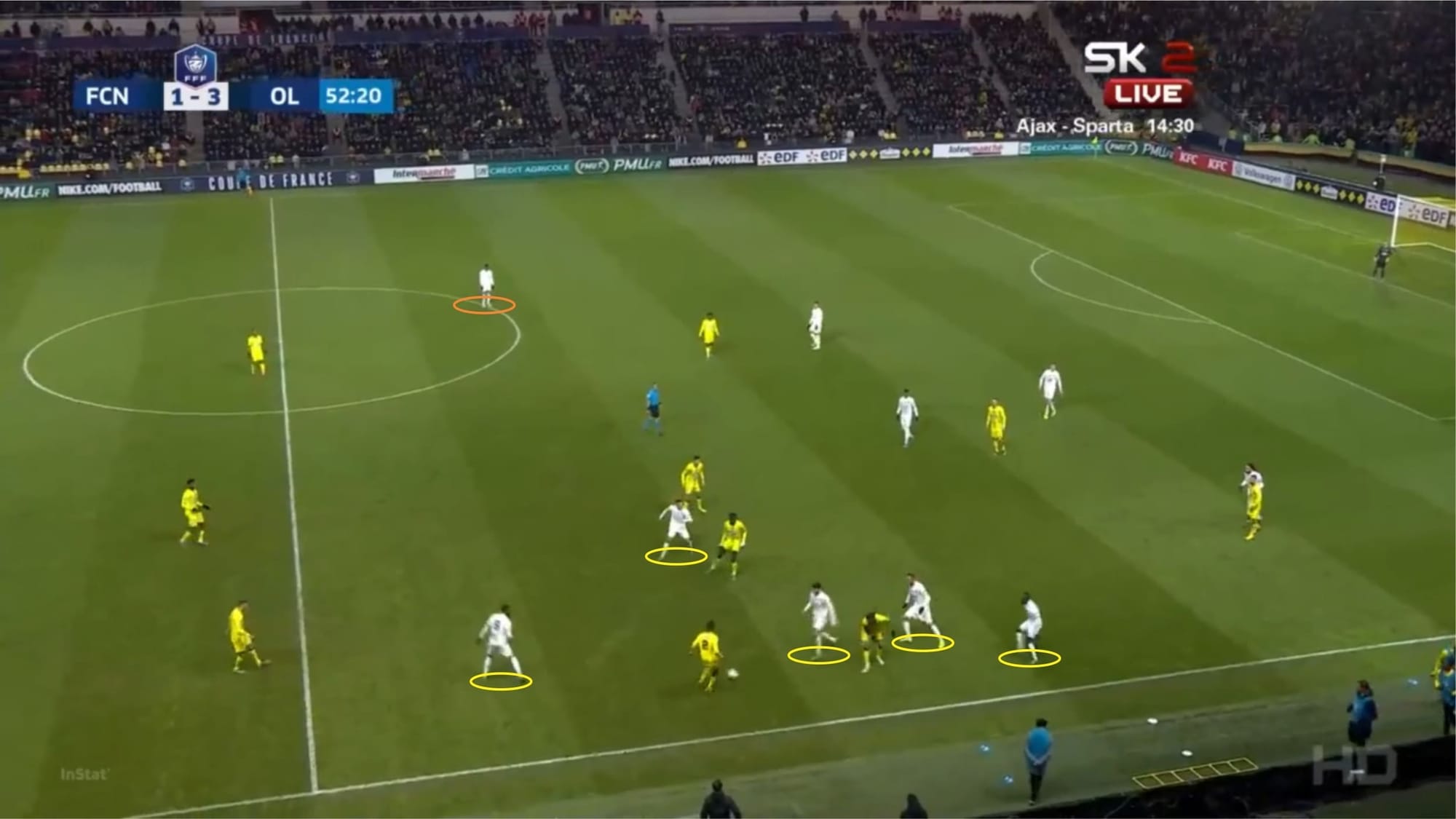
Lyon always look to overload an area on the pitch. When the ball is on either flank, Lyon will look to overload that area, isolating the ball-carrier and preventing progression while potentially winning the ball as well. As you can see, Traoré stayed wide in this picture, anticipating if Nantes tried to switch play whilst also making himself available as a target for counter-attack if Lyon managed to regain possession.
Exploiting Lyon’s vulnerabilities
As mentioned before in this tactical analysis, Lyon looked to maintain their compactness at all times in defence. This means that at times, the defensive line will sit very high and leave a considerable amount of space behind them just like in the example above. This also means that at times, they’ll overload one area while leaving space on the other side of the pitch.
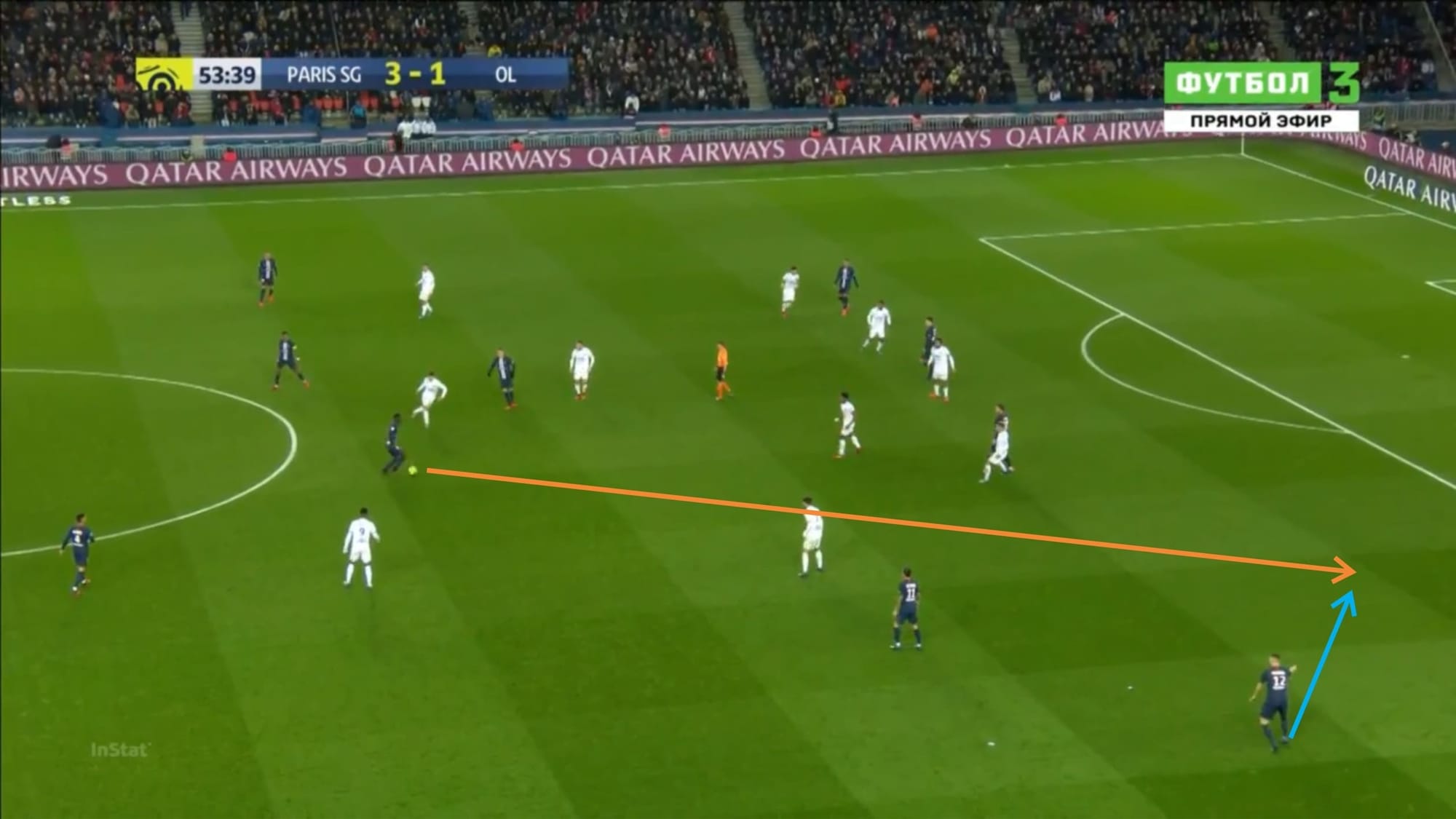
As in the example in the picture above. Lyon crowded the middle and managed to prevent Paris Saint-Germain from progressing and breaking through centrally. However, this left a generous amount of space for the opposing right-back to exploit.
If Marseille can attract Lyon’s pressure and play and force them to overload one area, Marseille can attack the open space by switching play quickly and accurately. Lyon seem to have the tendency to move their block rather slowly at times which can be quite beneficial for opposing teams.
Though they mainly defend zonally, Lyon’s third line still have the tendency to follow their man which means they can be moved/dragged out of position. Flexible and fluid movements in front of the defence can disrupt their organisation and cause serious trouble.
And finally, their vulnerability to losing the ball in the build-up.
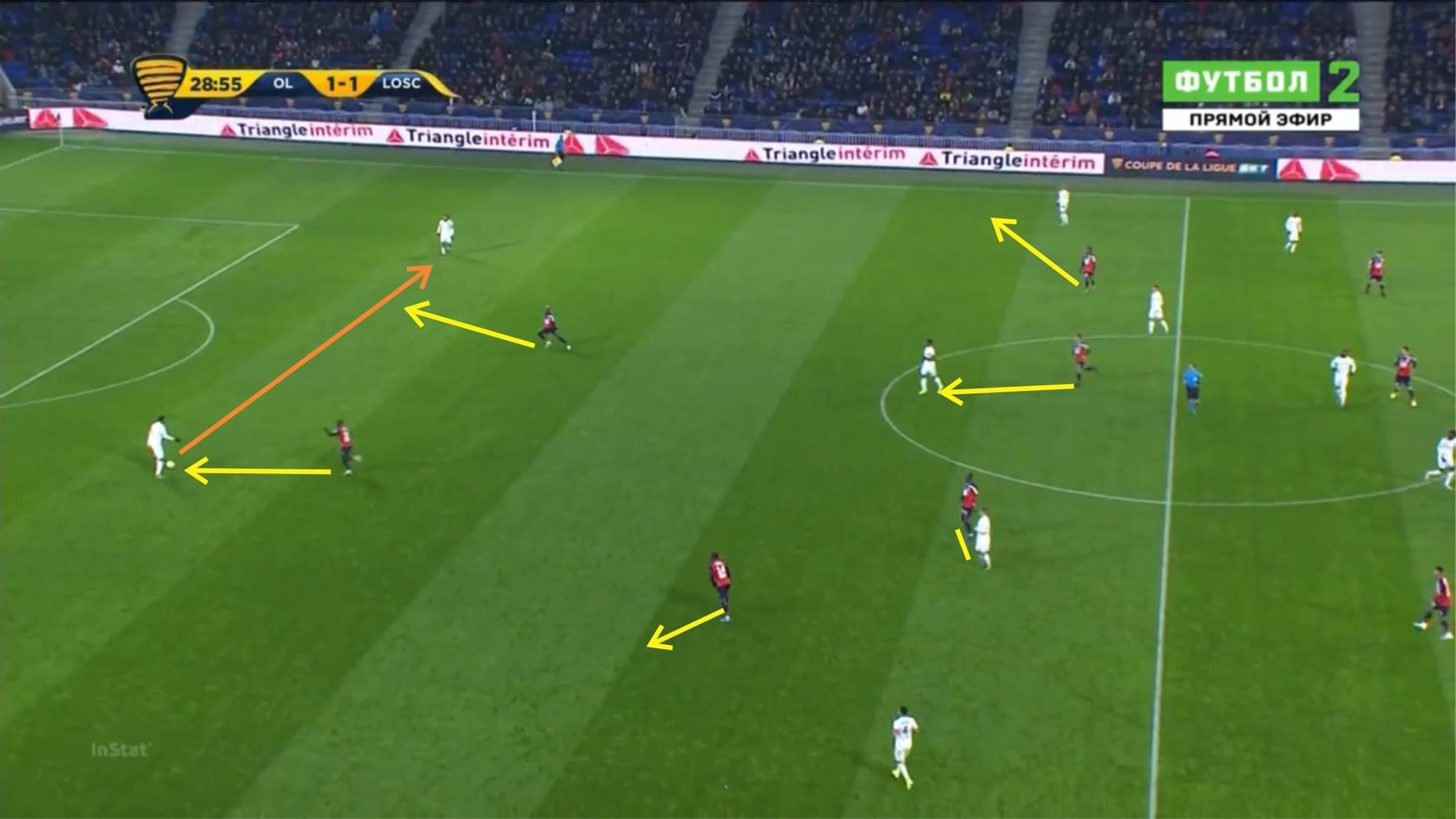
As mentioned before in this tactical analysis, Lyon tend to split their centre-backs and have their full-backs sit high in the build-up. However, against Lille, Lyon were really struggling to break through their first and second line of pressure. In this match, Lille defended with a compact medium-high 4-4-2 block with a combination of flexible man-marking and passing-lane marking. They will quickly compress space if the ball is played inside their block
In the situation above, Lyon’s right-sided centre-back (Marcelo) had possession of the ball but with Lille’s left-winger blocking the passing lane and the right-back (Rafael) sitting a bit too high, Marcelo decided not to play the ball to him.
If Marcelo played the ball to Mendes, Lille would compress space and aggressively swarm the ball-carrier which can lead to turnover. With Marcelo also being under pressure, he decided to take the risk and pass the ball-laterally towards the left-sided centre-back (Jason Denayer). One of Lille’s strikers (Victor Osimhen), however, failed to intercept the pass.
However, after Denayer received the pass, the same exact thing happened as when Marcelo had the ball. Passing lane to full-back marked, central areas inaccessible, and he’s receiving pressure from Osimhen. In this situation, Denayer tried his luck to pass the ball with pace towards the left-back but Renato Sanches of Lille was quick enough to intercept the pass and Lyon were immediately met with a 2v4 situation at the back. Lille ultimately failed to convert the chance into a goal.
Marseille can definitely cause trouble for Lyon if they can split the two centre-backs and isolate the ball-carrying centre-back by pressing him and blocking the marking the passing lane/blocking the access to progress the ball.
Marseille’s style of play
What’s quite clear in Marseille’s style of play is verticality. They are straightforward and direct but they don’t necessarily rely on long balls. What this means is that Marseille tend to look to progress the ball forward as quickly as possible but to achieve that they mainly use quick exchanges of passes (mostly short-medium range) and active movements of the players.
Villas-Boas usually deploys his team in a 4-1-4-1/4-3-3 formation although at times can be seen using a 3-5-2 and 4-2-3-1 system as well.
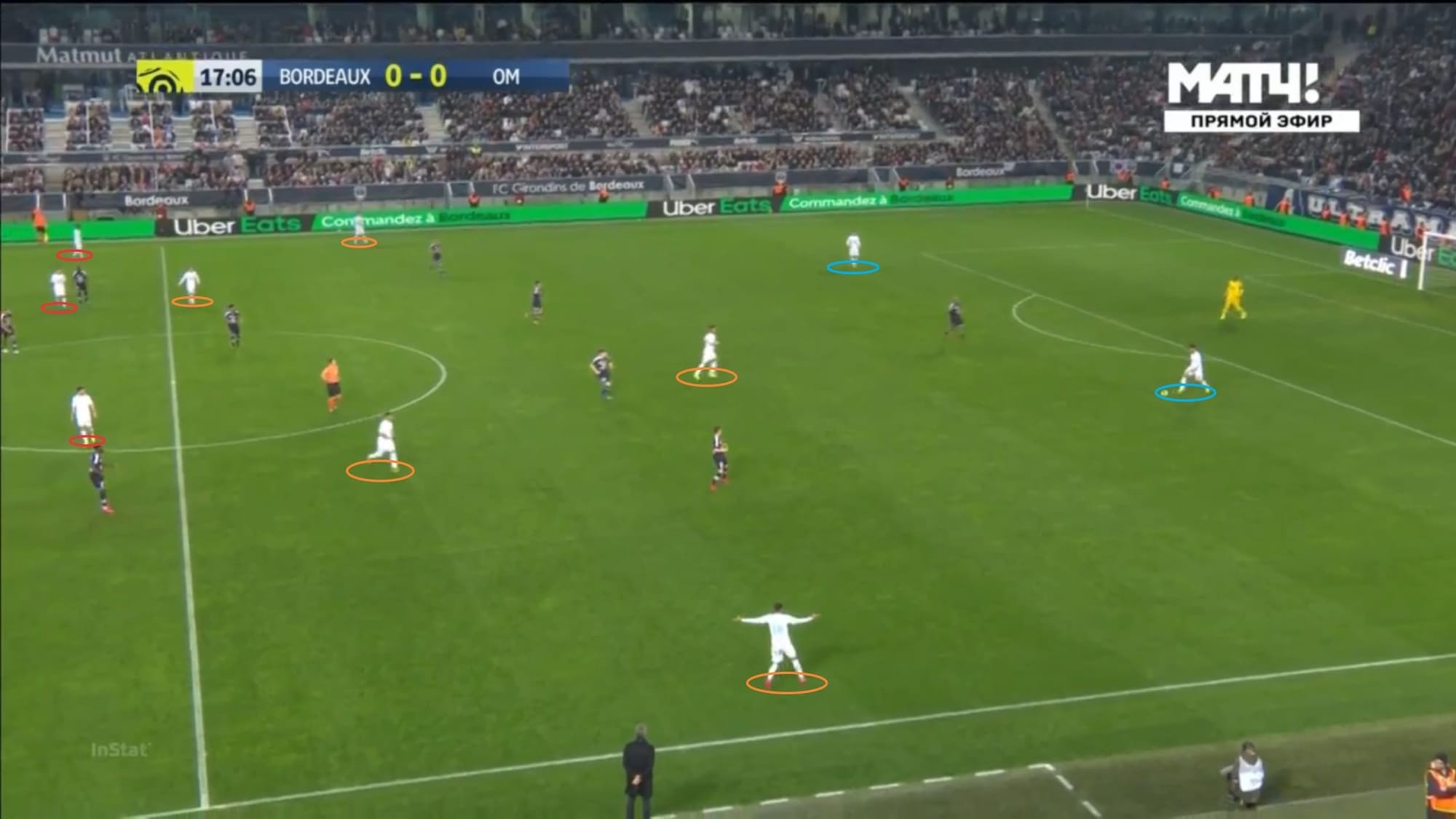
Marseille have the tendency to play from the back, moving the ball around rather patiently and looking for gaps to exploit. Though they’re quite patient at first, they’ll break with blistering pace once they manage to find/create that gap. At times, the goalkeeper will also choose to play the ball long instead of short towards either of the two centre-backs.
If they’re playing from the back, they will create the shape above in the build-up.
As you can see, both full-backs already sit high and wide. The defensive midfielder sits in the six space, looking to make himself available as the first receiver in midfield. Meanwhile, the two eights will look to stay in a more advanced area in and around the half-space. One of the two full-backs and central midfielders will drop back when needed.
Just like Lyon, Marseille have the tendency to attack through the flanks and the players also look to rotate positions as well.
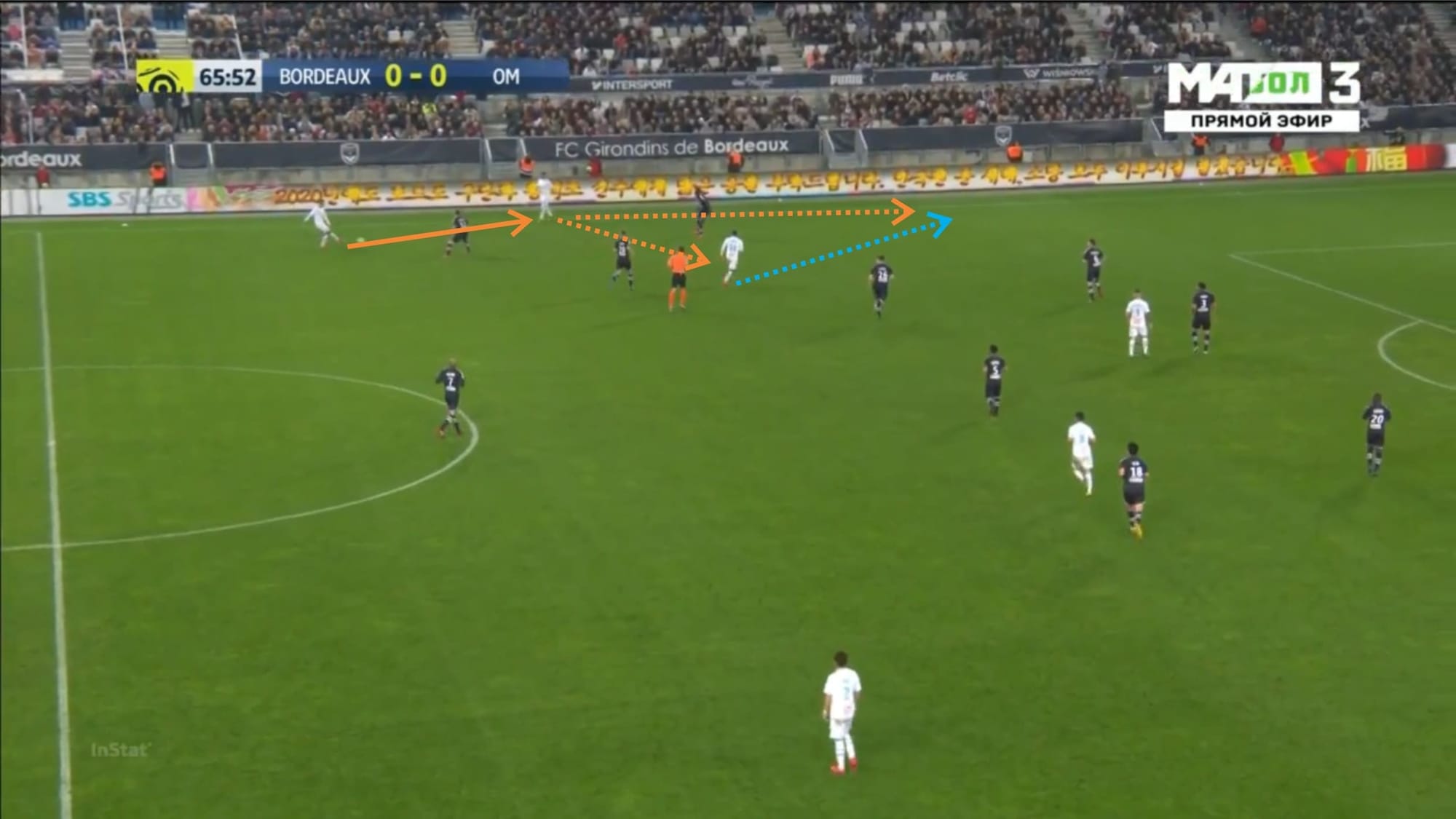
As you can see above, Marseille tend to combine a lot in the flanks in order to progress the ball and attack. The central midfielders, full-backs, and wingers always look to rotate positions and look for space in the wider areas and the half-spaces.
In the picture above, for example, Marseille’s left-sided central midfielder spotted space behind the opposing right-back and moved into it. Marseille’s left-winger received the ball from the left-back and had the option either to play the ball first-time into the feet of the central midfielder or play it through into space.
The movements, the rotations, and the creation of passing triangles are similar to what Lyon do, but what’s different is the tempo of their play. As mentioned before in this tactical analysis, Marseille look to play very quickly with a very high tempo. They’d exchange passes with few touches rather than dwell on the ball.
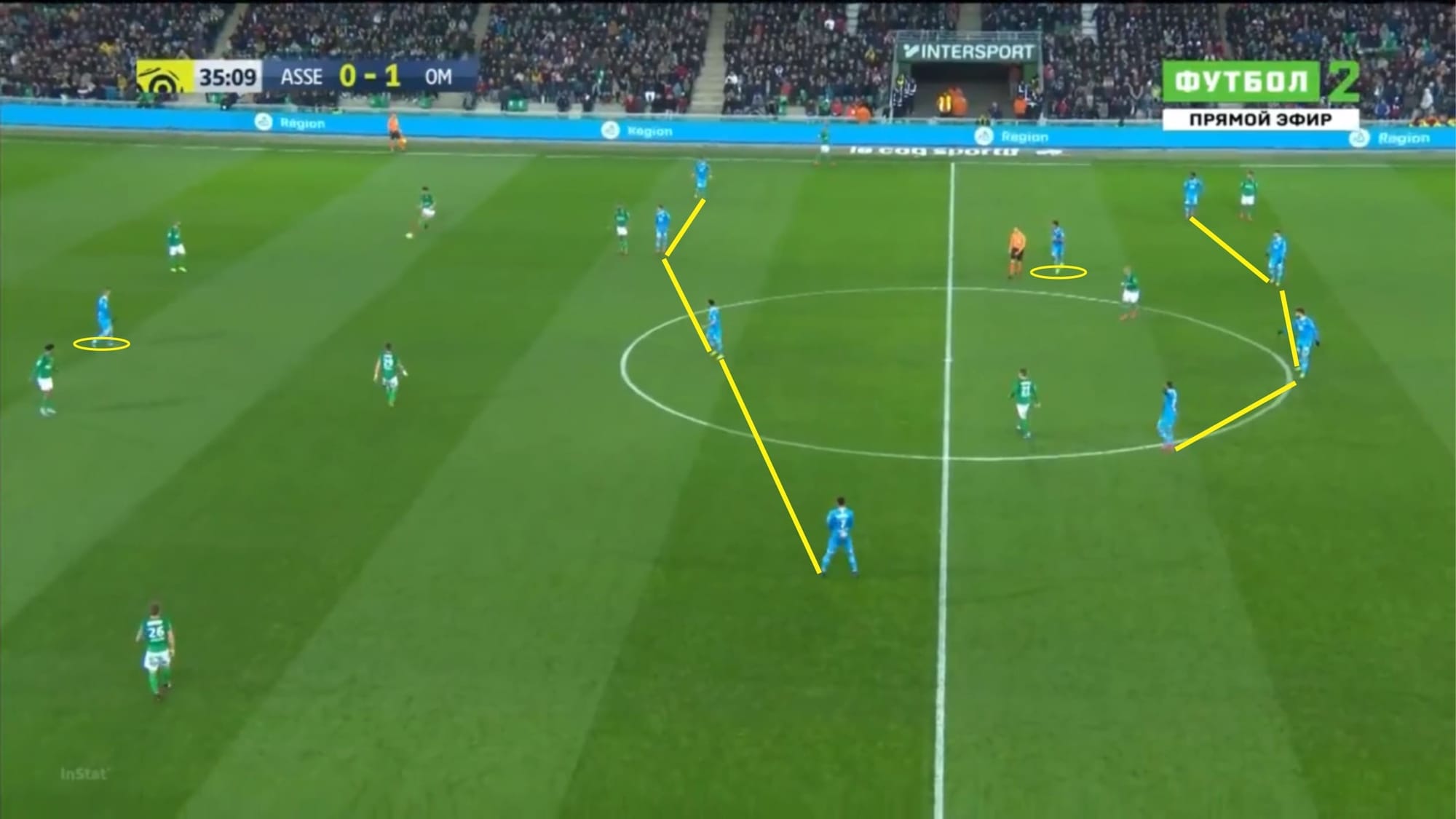
In defence, Marseille will look to defend with a 4-1-4-1 block. Marseille generally look to defend in a medium-high block and apply minimal pressure at first whilst marking the nearest options and blocking the access to progress the ball. Forcing the opposing team to play a long ball or move the ball back.
When the ball is played back or when the opposing player commits a mistake or when the ball-carrier is in a difficult position, Marseille immediately trigger their pressing trap with their players pushing forward and pressing the ball whilst closely marking the near options which can render the opposing ball-carrier very uncomfortable and in unfavourable position which is deep inside their own half.
Marseille mainly use situational man coverage in defence which means that they use a combination of man or option-oriented coverage as well as space coverage in certain situations.
The lone striker is their first line of pressure and this player always looks to press the centre-back from inside of the field and force the ball to move outwards. This is to split the two centre-backs and steer the ball-carrier towards the flank where they can trigger their pressing trap.
Marseille’s weaknesses
As mentioned before in this tactical analysis, Marseille always look to trigger a pressing trap when their opponents are in an uncomfortable position to try and regain possession in advanced areas. However, this pressing trap can make themselves a bit vulnerable, especially if the opposing team successfully escaped the pressure.
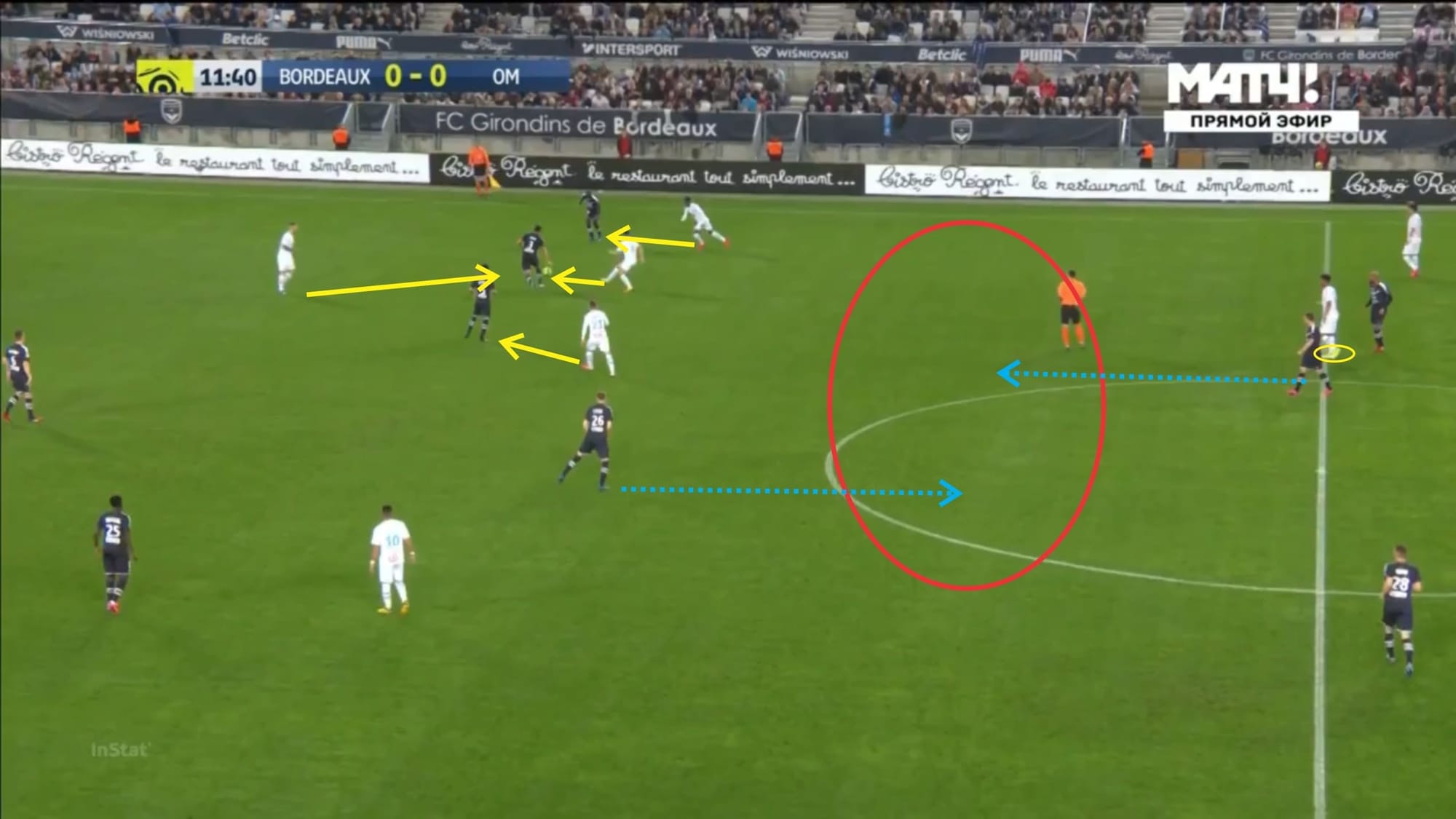
As you can see in the picture above, Marseille’s second line and the first line will push forward and press and swarm the ball whilst also marking the near options. However, the defensive midfielder (in this case, Boubacar Kamara) tends not to push forward but rather stay deep and close to the defensive line. This creates a gap in the middle of the field that can be exploited by the opposition. An opposing player can drop or move into that space and make himself available for a pass. If the press fails and the pass is made then Marseille will be in some trouble.
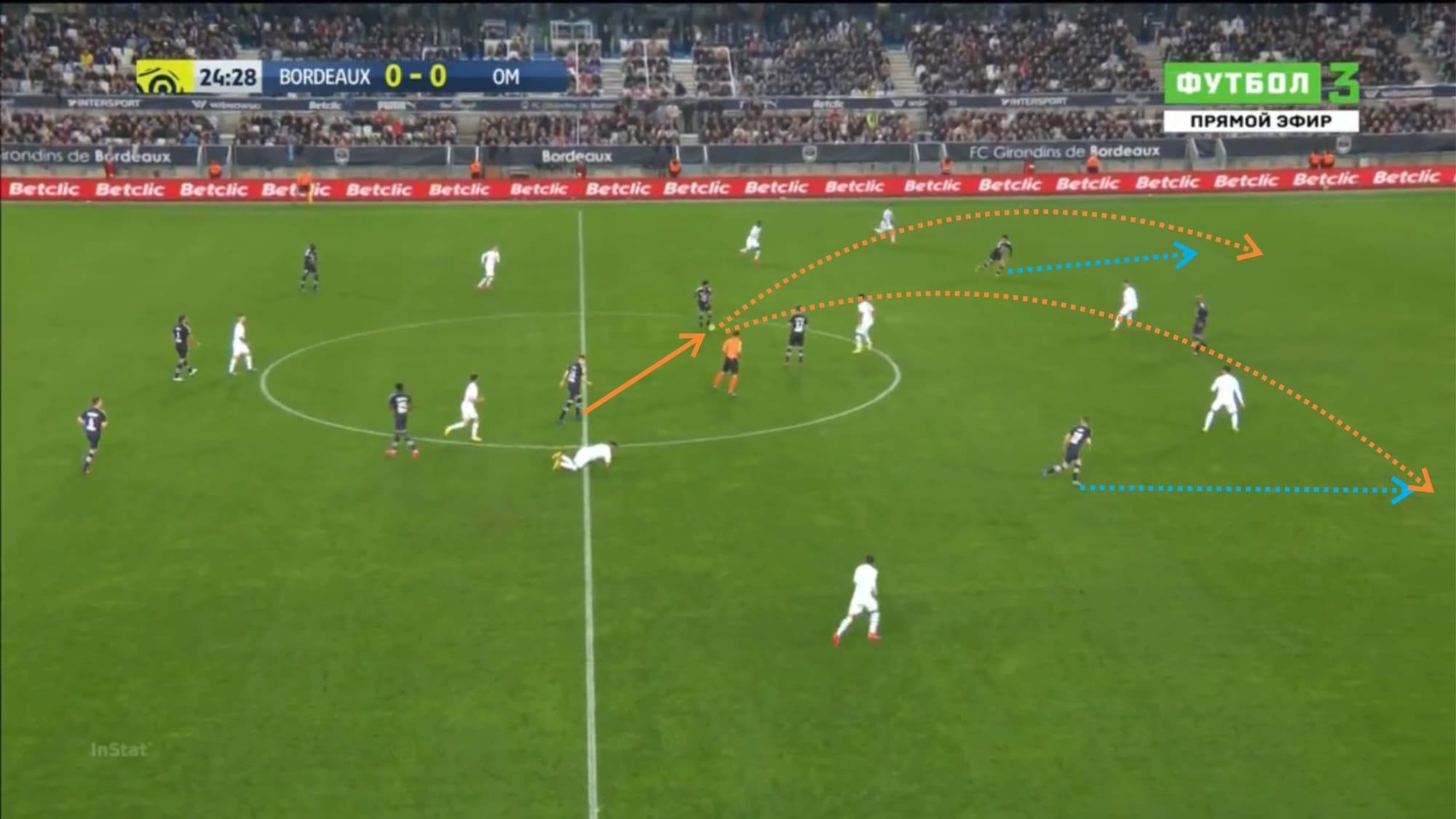
Marseille also have this tendency to play the ball long if the near options are unavailable. Sometimes the goalkeeper will also choose a long distribution rather than a short distribution. However, Marseille don’t really have a big man up front who can win aerial duels and bring the ball down or lay the ball off for his teammate. Instead, Marseille will try to regain control of the ball by winning the second ball or immediately pressing the ball to recover possession. With their full-backs tending to move quite high, their flanks can be quite vulnerable too.
In the picture above, for example, Bordeaux managed to win the aerial duel and collect the ball. With the full-backs out of position, the Bordeaux wingers immediately made runs into space. However, in this case, the pass from the Bordeaux midfielder was poor and ultimately, the attack ended although it could have been very dangerous for Marseille.
Lineups prediction
Marseille (4-3-3)
Starting XI: Mandanda – Sarr, González, Caleta-Car, Amavi – Kamara, Rongier, Sanson – Radonjic, Benedetto, Payet
Lyon (4-2-3-1)
Starting XI: Lopes – Tete, Andersen, Denayer, Marçal – Mendes, Tousart – Traoré, Aouar, Terrier – Dembélé
Conclusion
Lyon vs Marseille has always been a very exciting match watch. Both teams have exciting players at their disposals and both have excellent managers with interesting tactics and philosophies as well.
This might be a rather difficult match for Lyon to win. They have not been performing their best and morale has been quite low. Lyon have already booked a place in the final of Coupe de la Ligue but surely Garcia would want to reach the final of Coupe de France as well.
Meanwhile, Villas-Boas only need to be smart and play to their strengths here. They’ve successfully beaten Lyon once this season and they know what it takes to defeat Lyon.





Comments